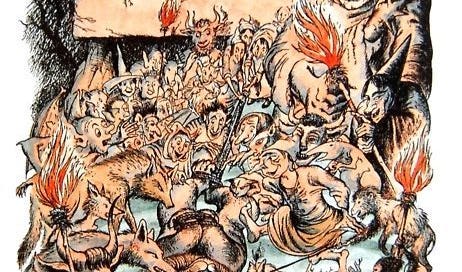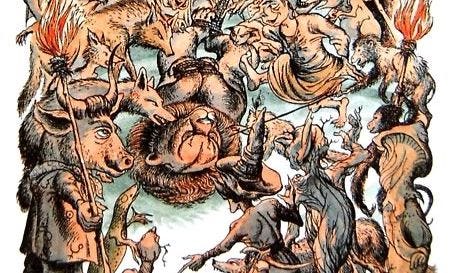Inspiration of “The Triumph of the Witch”
In “The Triumph of the Witch,” Susan and Lucy cry bitterly “though they hardly know why.” The same could be said for Pauline Baynes as she illustrated the death of Aslan. Drawing the great lion surrounded by evil creatures at the Stone Table, she wept. Only years later did she realize exactly why she was weeping.
In her mid-20s, Baynes secured a job illustrating Farmer Giles of Ham, a novella by J.R.R. Tolkien. He had rejected illustrations by another artist but was so enamored with Baynes’ work for the book that he suggested she illustrate his next story—what came to be The Lord of the Rings. The publisher didn’t think she was the right fit for that epic, but Tolkien did use her for other stories. A friend of Tolkien also appreciated her work on Farmer Giles of Ham and asked about her illustrating his new children’s series. Of course, that friend was C.S. Lewis.
While Baynes and Tolkien developed a friendship, she and Lewis only met three times and their relationship never moved beyond professional. After one of their encounters, apparently none too impressed, Baynes wrote in her diary, “Met C.S. Lewis. Came home. Made rock cakes.” In their interactions, Lewis praised her work effusively but expressed doubts and disagreements when talking with others. For his part, Lewis felt as if he couldn’t criticize her work because she became too upset at the mildest rebuke. Baynes recalls Lewis only rarely giving feedback on her work. Some of the awkwardness between the two may have originated with Lewis. He once told friend George Sayer, “Pauline is far too pretty.”
In the end, despite illustrating numerous other books, Baynes is most closely associated with Narnia and Lewis did appreciate her contributions to his fictional world. After Lewis received the Carnegie Medal, a British literary award given annually to one outstanding new children’s or young adult work, for The Last Battle, he wrote to Baynes: “Is it not really ‘our’ Medal? I’m sure the illustrations were taken into considerations as well as the text.”
And it was supposedly not until after The Last Battle that Baynes realized why she her illustrations of Aslan’s death had been tear-stained. Though he was innocent, one of ultimate goodness was killed by evil, for the sake of the guilty. Aslan was a picture of Jesus, and Baynes had been moved to tears by the story of His sacrifice.
Keep reading with a 7-day free trial
Subscribe to The Wardrobe Door to keep reading this post and get 7 days of free access to the full post archives.






